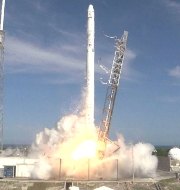SpaceX Falcon 9 rocket successfully launches inflatable room to ISS
Private SpaceX Falcon 9 rocket contracted by NASA has successfully launched the first inflatable habitat room that will attach to the International Space Station (ISS).
The Falcon 9 rocket lifted off on schedule from Cape Canaveral Air Force Station in Florida, United States.
In another major success for SpaceX, the reusable main stage booster of Falcon 9 rocket for the first time successfully landed on an ocean (floating) platform, known as a drone ship, off the coast of Florida.
Key facts
- The inflatable room has been named as Bigelow Expandable Actitvity Module (BEAM) and has been built by Nevada Company Bigelow Aerospace.
- It will be attached to the ISS for a two-year test and is the first such habitat to hold humans in orbit.
- It is made up of aluminium and soft fabric. It expands in space and is light weight and also takes minimal space. It creates place for astronauts to live and work.
- Its test is intended to pave the way towards the use of such rooms for long space trips, including to Mars and this technology could also help to create homes on Mars.
It should be noted that this was also the first NASA cargo run for SpaceX since its June 2015 mishap, when an unmanned cargo rocket exploded soon after take-off.
About SpaceX Falcon 9 rocket
- Falcon 9 rocket is a two-stage rocket designed and manufactured by Space Exploration Technologies Corporation (SpaceX), a private space transport services company.
- It is basically used for the reliable and safe transport of satellites and the Dragon spacecraft into orbit.
- It is powered by liquid oxygen (LOX) and rocket-grade kerosene (RP-1) propellants.
- In 2008, SpaceX’s Falcon 9 and Dragon capsule combination had won a Commercial Resupply Services (CRS) contract from NASA to resupply the ISS under the Commercial Orbital Transportation Services (COTS) program.
Month: Current Affairs - April, 2016


